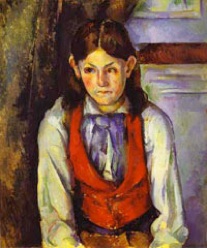“Art requires philosophy, just as philosophy requires art. Otherwise, what would become of beauty?”*
I went to the Musee D’Orsey in Paris to see my Manet, Monet and Renoir and the rest of the Impressionists I have been studying for the last months. To my sheer delight the museum was also holding a special exhibition of impressionist’s paintings from other parts of the world. Many artists that I had only seen on DVD, and never expected to see, were on display in this most wonderful of museums. The exhibition was called, “From Cezanne to Picasso, Masterpieces from the Vollard Gallery” and it showed paintings that were originally collected and sold by a famous art dealer in the 19th century,
Ambroise Vollard (1866-1939). Here in Paris, not only did I get to see the regular painting of the D’Orsey, but also paintings from museums all over the world: London, New York, Rome, Washington, St Petersburg, Chicago, and even Prague and Frankfurt. What can I say? To have studied the art in advance and then to see the painting itself is the most satisfying of all experiences! This world is full of so much beauty; and in the hallways of the world greatest museums one can walk for an eternity past painting after painting, but at least here in the D’Orsey, I am trying to walk past some of it with trained eyes.
As I sat in the D’Orsey and then later in the Louvre, I asked myself why are these paintings here? Are they good art? What constitutes good art and what is beauty? This exhibition has taught me something valuable: that there was much more to art than just the paintings. There are the painters and the times in which they lived, their hopes and desires and needs.
And then there are the kings, the queens, the churches, the wealthy merchants and the art buying public who made it possible for these artists to live and work. In the case of these French Impressionists it was the art dealers and the art buying public that supported them.
The exhibition was as much about the art dealer, Amborise Vollard as it was about Cezanne and Picasso and the others. Without Vollard’s passion to collect art, and ultimately his desire for money, many of theses Impressionists would have remained common street painters. Picasso and Cezanne did not start out being Picasso or Cezanne. Dealers like Vollard “discovered,” encouraged and financed them. It was Vollard who brought many of these painters into the world’s spotlight. A lot of what puts paintings into museums are the patrons, the kings and queens, the merchants and the dealers, who desire to promote the art and the artists. What constitutes good art is often more controlled by fashion, politics, economics and good luck than pure aesthetics. As I walked though these museums, I began to ask myself, would I buy these painting if I had the means? Do I like this art? Would I hang that particular painting on my wall? And the answer in many cases is no! Monet has become world famous and his paintings, just by reason of his name, bring handsome fortunes regardless of the artistic merit, but Monet was a man and I am sure he had “ bad painting days” and yet some of that art is hanging on the walls of the D’ Orsey. In spite of this I still hear the crowds of viewers gasping “ooh ah” in appreciation. The same can be said of Picasso and every other artist. They all had their off days.

Boy in a Red Waistcoat.1888-1890 Paul Cezanne. Barnes Foundation, Lincoln University, Philadelphia, PA, USA
The first time I confronted the Monalisa I just saluted and walked by. I had no patience to endure the crowds. This time, in spite of the crowd, I sat before this work and studied it as closely as I could. The world comes to the door of the Monalisa and bows its head in awe, but is the painting good art? Or is the fame of this painting just the marketing of the skillful dealers of the day who desired money? As I gazed upon this painting and looked into the eyes of the Monalisa I came to see that indeed this painting does touch something deep within me. There is such a thing as good art. There is something universal and positive about beauty; it is not simply the cessation of chaos. There is good art, and the closer a painter can come to capturing this “something,” the universals that we construe as beauty, the better the chances are the art will pass the test of time and history and find its place onto one of the hallways of the world’s museums. So I believe there is good art and that good art does transcends the fashions, politics and economics of its time.
I also decided that I want more of this art in my life, so I plan to buy a few pieces. I want to “discover” my own Renoir and Manet in the streets of the world, and so now each time I look at a painting I ask,
Do I like it? Does it have beauty? Do I want it hanging in my home? And, can I afford it? These are practical questions that every “Monet” “Picasso” and “Cezanne” has to be judged by. And now I, as a new member of the art buying public, am trying to discern art with educated eyes. I have begun to search for the universals that may be hidden within a painting that I see on the streets of Monmartre or Rome or anywhere else.
*Paul Gauguin (1848-1903), French artist.


